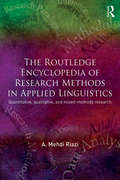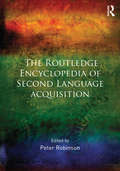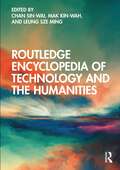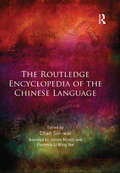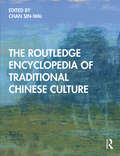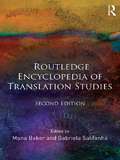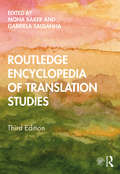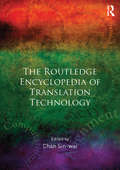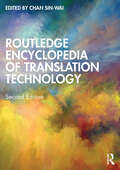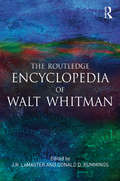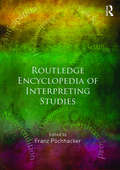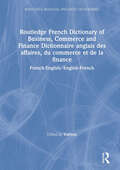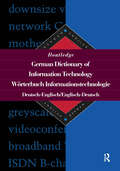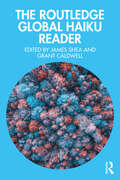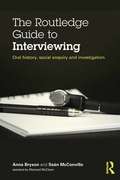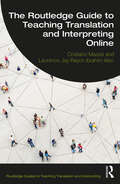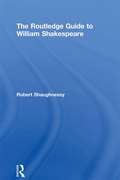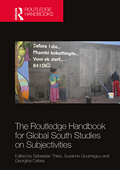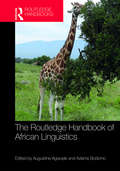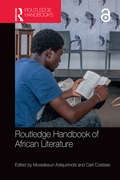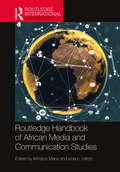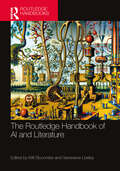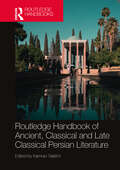- Table View
- List View
The Routledge Encyclopedia of Research Methods in Applied Linguistics
by A. Mehdi RiaziThe Routledge Encyclopedia of Research Methods in Applied Linguistics provides accessible and concise explanations of key concepts and terms related to research methods in applied linguistics. Encompassing the three research paradigms of quantitative, qualitative, and mixed methods, this volume is an essential reference for any student or researcher working in this area. This volume provides: A–Z coverage of 570 key methodological terms from all areas of applied linguistics; detailed analysis of each entry that includes an explanation of the head word, visual illustrations, cross-references to other terms, and further references for readers; an index of core concepts for quick reference. Comprehensively covering research method terminology used across all strands of applied linguistics, this encyclopedia is a must-have reference for the applied linguistics community.
The Routledge Encyclopedia of Second Language Acquisition
by Peter RobinsonThe Routledge Encyclopedia of Second Language Acquisition offers a user-friendly, authoritative survey of terms and constructs that are important to understanding research in second language acquisition (SLA) and its applications. The Encyclopedia is designed for use as a reference tool by students, researchers, teachers and professionals with an interest in SLA. The Encyclopedia has the following features: • 252 alphabetized entries written in an accessible style, including cross references to other related entries in the Encyclopedia and suggestions for further reading • Among these, 9 survey entries that cover the foundational areas of SLA in detail: Development in SLA, Discourse and Pragmatics in SLA, Individual Differences in SLA, Instructed SLA, Language and the Lexicon in SLA, Measuring and Researching SLA, Psycholingustics of SLA, Social and Sociocultural Approaches to SLA, Theoretical Constructs in SLA. • The rest of the entries cover all the major subdisciplines, methodologies and concepts of SLA, from “Accommodation” to the “ZISA project.” Written by an international team of specialists, the Routledge Encyclopedia of Second Language Acquisition is an invaluable resource for students and researchers with an academic interest in SLA.
Routledge Encyclopedia of Technology and the Humanities
by Chan Sin-Wai Mak Kin-Wah Leung Sze MingRoutledge Encyclopedia of Technology and the Humanities is a pioneer attempt to introduce a wide range of disciplines in the emerging field of techno-humanities to the English-reading world.This book covers topics such as archaeology, cultural heritage, design, fashion, linguistics, music, philosophy, and translation. It has 20 chapters, contributed by 26 local and international scholars. Each chapter has its own theme and addresses issues of significant interest in the respective disciplines. References are provided at the end of each chapter for further exploration into the literature of the relevant areas. To facilitate an easy reading of the information presented in this volume, chapters have been arranged according to the alphabetical order of the topics covered.This Encyclopedia will appeal to researchers and professionals in the field of technology and the humanities, and can be used by undergraduate and graduate students studying the humanities.
The Routledge Encyclopedia of the Chinese Language
by Sin-Wai ChanThe Routledge Encyclopedia of the Chinese Language is an invaluable resource for language learners and linguists of Chinese worldwide, those interested readers of Chinese literature and cultures, and scholars in Chinese studies. Featuring the research on the changing landscape of the Chinese language by a number of eminent academics in the field, this volume will meet the academic, linguistic and pedagogical needs of anyone interested in the Chinese language: from Sinologists to Chinese linguists, as well as teachers and learners of Chinese as a second language. The encyclopedia explores a range of topics: from research on oracle bone and bronze inscriptions, to Chinese language acquisition, to the language of the mass media. This reference offers a guide to shifts over time in thinking about the Chinese language as well as providing an overview of contemporary themes, debates and research interests. The editors and contributors are assisted by an editorial board comprised of the best and most experienced sinologists world-wide. The reference includes an introduction, written by the editor, which places the assembled texts in their historical and intellectual context. The Encyclopedia of the Chinese Language is destined to be valued by scholars and students as a vital research resource.
The Routledge Encyclopedia of Traditional Chinese Culture
by Chan Sin-WaiThe Routledge Encyclopedia of Traditional Chinese Culture offers an in-depth discussion of cultural aspects of China from the ancient period to the pre-modern era, lasting over 5,000 years, comprised of 7,000 word pieces by more than 20 world-leading academics and experts. Addressing areas such as China studies, cultural studies, cultural management, and more specific areas – such as religion, opera, Chinese painting, Chinese calligraphy, material culture, performing arts, and visual arts – this encyclopedia covers all major aspects of traditional Chinese culture. The volume is intended to be a detailed reference for graduate students on a variety of courses, and also for undergraduate students on survey courses to Chinese culture.
Routledge Encyclopedia of Translation Studies
by Mona Baker Gabriela SaldanhaPraise for the previous edition of the Encyclopedia of Translation Studies: 'Translation has long deserved this sort of treatment. Appropriate for any college or university library supporting a program in linguistics, this is vital in those institutions that train students to become translators.' – Rettig on Reference 'Congratulations should be given to Mona Baker for undertaking such a mammoth task and...successfully pulling it off. It will certainly be an essential reference book and starting point for anyone interested in translation studies.' – ITI Bulletin'This excellent volume is to be commended for bringing together some of [its] most recent research. It provides a series of extremely useful short histories, quite unlike anything that can be found elsewhere. University teachers will find it invaluable for preparing seminars and it will be widely used by students.' – The Times Higher Education Supplement' ... a pioneering work of reference ...'– Perspectives on Translation The Routledge Encyclopedia of Translation Studies has been the standard reference in the field since it first appeared in 1998. The second, extensively revised and extended edition brings this unique resource up-to-date and offers a thorough, critical and authoritative account of one of the fastest growing disciplines in the humanities. The Encyclopedia is divided into two parts and alphabetically ordered for ease of reference. Part One (General) covers the conceptual framework and core concerns of the discipline. Categories of entries include: central issues in translation theory (e.g. equivalence, translatability, unit of translation) key concepts (e.g. culture, norms, ethics, ideology, shifts, quality) approaches to translation and interpreting (e.g. sociological, linguistic, functionalist) types of translation (e.g. literary, audiovisual, scientific and technical) types of interpreting (e.g. signed language, dialogue, court). New additions in this section include entries on globalisation, mobility, localization, gender and sexuality, censorship, comics, advertising and retranslation, among many others. Part Two (History and Traditions) covers the history of translation in major linguistic and cultural communities. It is arranged alphabetically by linguistic region. There are entries on a wide range of languages which include Russian, French, Arabic, Japanese, Chinese and Finnish, and regions including Brazil, Canada and India. Many of the entries in this section are based on hitherto unpublished research. This section includes one new entry: Southeast Asian tradition. Drawing on the expertise of over 90 contributors from 30 countries and an international panel of consultant editors, this volume offers a comprehensive overview of translation studies as an academic discipline and anticipates new directions in the field. The contributors examine various forms of translation and interpreting as they are practised by professionals today, in addition to research topics, theoretical issues and the history of translation in various parts of the world. With key terms defined and discussed in context, a full index, extensive cross-references, diagrams and a full bibliography the Routledge Encyclopedia of Translation Studies is an invaluable reference work for all students and teachers of translation, interpreting, and literary and social theory. Mona Baker is Professor of Translation Studies at the University of Manchester, UK. She is co-founder and editorial director of St Jerome Publishing, a small press specializing in translation studies and cross-cultural communication. Apart from numerous papers in scholarly journals and collected volumes, she is
Routledge Encyclopedia of Translation Studies
by Mona Baker Gabriela SaldanhaThe Routledge Encyclopedia of Translation Studies remains the most authoritative reference work for students and scholars interested in engaging with the phenomenon of translation in all its modes and in relation to a wide range of theoretical and methodological traditions. This new edition provides a considerably expanded and updated revision of what appeared as Part I in the first and second editions. Featuring 132 as opposed to the 75 entries in Part I of the second edition, it offers authoritative, critical overviews of additional topics such as authorship, canonization, conquest, cosmopolitanism, crowdsourced translation, dubbing, fan audiovisual translation, genetic criticism, healthcare interpreting, hybridity, intersectionality, legal interpreting, media interpreting, memory, multimodality, nonprofessional interpreting, note-taking, orientalism, paratexts, thick translation, war and world literature. Each entry ends with a set of annotated references for further reading. Entries no longer appearing in this edition, including historical overviews that previously appeared as Part II, are now available online via the Routledge Translation Studies Portal. Designed to support critical reflection, teaching and research within as well as beyond the field of translation studies, this is an invaluable resource for students and scholars of translation, interpreting, literary theory and social theory, among other disciplines.
Routledge Encyclopedia of Translation Technology
by Sin-Wai ChanThe Routledge Encyclopedia of Translation Technology provides a state-of-the art survey of the field of computer-assisted translation. It is the first definitive reference to provide a comprehensive overview of the general, regional and topical aspects of this increasingly significant area of study. The Encyclopedia is divided into three parts: Part One presents general issues in translation technology, such as its history and development, translator training and various aspects of machine translation, including a valuable case study of its teaching at a major university; Part Two discusses national and regional developments in translation technology, offering contributions covering the crucial territories of China, Canada, France, Hong Kong, Japan, South Africa, Taiwan, the Netherlands and Belgium, the United Kingdom and the United States Part Three evaluates specific matters in translation technology, with entries focused on subjects such as alignment, bitext, computational lexicography, corpus, editing, online translation, subtitling and technology and translation management systems. The Routledge Encyclopedia of Translation Technology draws on the expertise of over fifty contributors from around the world and an international panel of consultant editors to provide a selection of articles on the most pertinent topics in the discipline. All the articles are self-contained, extensively cross-referenced, and include useful and up-to-date references and information for further reading. It will be an invaluable reference work for anyone with a professional or academic interest in the subject.
Routledge Encyclopedia of Translation Technology
by Chan Sin-WaiRoutledge Encyclopedia of Translation Technology, second edition, provides a state-of-the-art survey of the field of computer-assisted translation. It is the first definitive reference to provide a comprehensive overview of the general, regional, and topical aspects of this increasingly significant area of study. The Encyclopedia is divided into three parts: Part 1 presents general issues in translation technology, such as its history and development, translator training, and various aspects of machine translation, including a valuable case study of its teaching at a major university; Part 2 discusses national and regional developments in translation technology, offering contributions covering the crucial territories of China, Canada, France, Hong Kong, Japan, South Africa, Taiwan, the Netherlands and Belgium, the United Kingdom, and the United States; Part 3 evaluates specific matters in translation technology, with entries focused on subjects such as alignment, concordancing, localization, online translation, and translation memory. The new edition has five additional chapters, with many chapters updated and revised, drawing on the expertise of over 50 contributors from around the world and an international panel of consultant editors to provide a selection of chapters on the most pertinent topics in the discipline. All the chapters are self-contained, extensively cross-referenced, and include useful and up-to-date references and information for further reading. It will be an invaluable reference work for anyone with a professional or academic interest in the subject.
Routledge Encyclopedia of Translation Technology
by Chan Sin-WaiRoutledge Encyclopedia of Translation Technology, second edition, provides a state-of-the-art survey of the field of computer-assisted translation. It is the first definitive reference to provide a comprehensive overview of the general, regional, and topical aspects of this increasingly significant area of study. The Encyclopedia is divided into three parts: Part 1 presents general issues in translation technology, such as its history and development, translator training, and various aspects of machine translation, including a valuable case study of its teaching at a major university; Part 2 discusses national and regional developments in translation technology, offering contributions covering the crucial territories of China, Canada, France, Hong Kong, Japan, South Africa, Taiwan, the Netherlands and Belgium, the United Kingdom, and the United States; Part 3 evaluates specific matters in translation technology, with entries focused on subjects such as alignment, concordancing, localization, online translation, and translation memory. The new edition has five additional chapters, with many chapters updated and revised, drawing on the expertise of over 50 contributors from around the world and an international panel of consultant editors to provide a selection of chapters on the most pertinent topics in the discipline. All the chapters are self-contained, extensively cross-referenced, and include useful and up-to-date references and information for further reading. It will be an invaluable reference work for anyone with a professional or academic interest in the subject.
The Routledge Encyclopedia of Walt Whitman (Blackwell Companions To Literature And Culture Ser.)
by J. R. LeMaster Donald D. KummingsThe Routledge Encyclopedia of Walt Whitman presents a comprehensive resource complied by over 200 internationally recognized contributors, including such leading Whitman scholars as James E. Miller, Jr., Roger Asselineau, Betsy Erkkila, and Joel Myerson. Now available for the first time in paperback, this volume comprises more than 750 entries arranged in convenient alphabetical format. Coverage includes: biographical information: all names, dates, places, and events important to understanding Whitman's life and careerWhitman's works: essays on all eight editions of Leaves of Grass, major poems and poem clusters, principal essays and prose works, as well as his more than two dozen short stories and the novel, Franklin Evansprominent themes and concepts: essays on such major topics as democracy, slavery, the Civil War, immortality, sexuality, and the women's rights movement.significant forms and techniques: such as prosody, symbolism, free verse, and humourimportant trends and critical approaches in Whitman studies: including new historicist and cultural criticism, psychological explorations, and controversial issues of sexual identitysurveys of Whitman's international impact as well as an assessment of his literary legacy. Useful for students, researchers, librarians, teachers, and Whitman devotees, this volume features extensive cross-references, numerous photographs of the poet, a chronology, a special appendix section tracking the poet's genealogy, and a thorough index. Each entry includes a bibliography for further study.
ROUTLEDGE ENCYCLOPEDIA OF INTERPRETING STUDIES
by Franz PochhackerThe Routledge Encyclopedia of Interpreting Studies is the authoritative reference for anyone with an academic or professional interest in interpreting. Drawing on the expertise of an international team of specialist contributors, this single-volume reference presents the state of the art in interpreting studies in a much more fine-grained matrix of entries than has ever been seen before. For the first time all key issues and concepts in interpreting studies are brought together and covered systematically and in a structured and accessible format. With all entries alphabetically arranged, extensively cross-referenced and including suggestions for further reading, this text combines clarity with scholarly accuracy and depth, defining and discussing key terms in context to ensure maximum understanding and ease of use. Practical and unique, this Encyclopedia of Interpreting Studies presents a genuinely comprehensive overview of the fast growing and increasingly diverse field of interpreting studies.
Routledge French Dictionary of Business, Commerce and Finance Dictionnaire anglais des affaires, du commerce et de la finance: French-English/English-French (Routledge Bilingual Specialist Dictionaries)
by VariousThis dictionary consists of some 100,000 terms and references in bith French and English, including 4,000 abbreviations. over 45 subject areas are covered, including: * Accountancy * Banking * Business Administration * Computing * Economics * Environment * Finance * General Commerce * Human Resource Management * Import/Export * Industry * Insurance * Law * Leisure * Management * Mathematics * Media * Patents * Politics * Property * Sales & Marketing * Stock Market * Taxation * Tourism * Transport * Welfare & Safety. Also included is a comprehensive up-to-date reference section on countries, business correspondence and situations, job titles, stock exchanges, economic indexes and numbers.KEY FEATURESTerm Specialists - the terms list has been checked by over 100 sources including experts from Apple France * Association Française des Banques * Chartered Institute of Banking * France Telecom * Institute of European Trade and Technology * American Graduate School of Management * London School of Economics * Ecole supérieure de commerce de Lyon * Department of Trade and Industry * Law Society * University of Reading * Environment Council * University of Bath * Centre de Recherche et de Gestion * Manchester Business School * Ecole supérieure internationale de commerce and Ecole des hautes études commerciales de Montrial(HEC).Prestigous experts - include Prof. Chris Nobes, Prof. Michel Péron, Prof. Gordon Shenton, Dr. Van de Yeught and Prof. Peter Walton.Native Speakers - all stages of compilation have included native speakers of French as well as English and extensive coverage of US as well as UK terminology.
Routledge German Dictionary of Information Technology Worterbuch Informationstechnologie: German-English/English-German (Routledge Bilingual Specialist Dictionaries)
by Sinda LópezThis thorough reference source is in-dispensible for translators working in the realms of artificial intelligence, computing, data processing, physics, online services and related disciplines. The dictionary also features hot translation links, indexed cross-references for easy, rapid access, and an intuitive screen environment while covering the most up-to-date terminology in this cutting edge subject area. Diese umfassende Referenzquelle ist für Übersetzer, die in den Bereichen künstliche Intelligenz, Informatik, Datenverarbeitung, Physik, Online-Dienste und verwandten Disziplinen arbeiten, unverzichtbar. Das Wörterbuch verfügt außerdem über „Hot Translation“-Links, indizierte Querverweise für einen einfachen und schnellen Zugriff sowie eine intuitive Bildschirmumgebung und deckt gleichzeitig die aktuellste Terminologie in diesem hochmodernen Themenbereich ab.
The Routledge Global Haiku Reader
by James Shea Grant CaldwellThe Routledge Global Haiku Reader provides a historical overview and comprehensive examination of haiku across the world in numerous languages, poetic movements, and cultural contexts. Offering an extensive critical perspective, this volume provides leading essays by poets and scholars who explore haiku’s various global developments, demonstrating the form’s complex and sometimes contradictory manifestations from the twentieth century to the present. The sixteen chapters are carefully organized into categories that reflect the salient areas of practice and study: Haiku in Transit, Haiku and Social Consciousness, Haiku and Experimentation, and The Future of Global Haiku. An insightful introduction surveys haiku’s influence beyond Japan and frames the collection historically and culturally, questioning commonly held assumptions about haiku and laying the groundwork for new ways of seeing the form. Haiku’s elusiveness, its resistance to definition, is partly what keeps it so relevant today, and this book traces the many ways in which this global verse form has evolved. The Routledge Global Haiku Reader ushers haiku into the twenty-first century in a critically minded and historically informed manner for a new generation of readers and writers and will appeal to students and researchers in Asian studies, literary studies, comparative literature, creative writing, and cultural studies
The Routledge Guide to Interviewing: Oral History, Social Enquiry and Investigation
by Sean McConville Anna BrysonThe Routledge Guide to Interviewing sets out a well-tested and practical approach and methodology: what works, difficulties and dangers to avoid and key questions which must be answered before you set out. Background methodological issues and arguments are considered and drawn upon but the focus is on what is ethical, legally acceptable and productive: Rationale (why, what for, where, how) Ethics and Legalities (informed consent, data protection, risks, embargoes) Resources (organisational, technical, intellectual) Preparation (selecting and approaching interviewees, background and biographical research, establishing credentials, identifying topics) Technique (developing expertise and confidence) Audio-visual interviews Analysis (modes, methods, difficulties) Storage (archiving and long-term preservation) Sharing Resources (dissemination and development) From death row to the mansion of a head of state, small kitchens and front parlours, to legislatures and presbyteries, Anna Bryson and Seán McConville’s wide interviewing experience has been condensed into this book. The material set out here has been acquired by trial, error and reflection over a period of more than four decades. The interviewees have ranged from the delightfully straightforward to the painfully difficult to the near impossible – with a sprinkling of those that were impossible. Successful interviewing draws on the survival skills of everyday life. This guide will help you to adapt, develop and apply these innate skills. Including a range of useful information such as sample waivers, internet resources, useful hints and checklists, it provides sound and plain-speaking support for the oral historian, social scientist and investigator.
The Routledge Guide to Teaching Ethics in Translation and Interpreting Education (Routledge Guides to Teaching Translation and Interpreting)
by Rebecca TiptonRoutledge Guides to Teaching Translation and Interpreting is a series of practical guides to key areas of translation and interpreting for instructors, lecturers, and course designers. This book provides university-level educators in translation and interpreting with a practical set of resources to support a pedagogically engaged approach to ethics. Encompassing critical engagement and reflection, the resources have been designed to be easily developed and adapted to specific teaching contexts. The book promotes an integrated approach to ethics teaching. Its core goals are to improve the quality of student learning about ethics, develop confidence in ethical decision-making, and enhance a commitment to ethics beyond the programme of study. The approach includes emphasis on problems of practice, or “ethical dilemmas”, using real-world examples, but simultaneously encompasses a more wide-ranging set of ethical questions for both educators and their students. Including chapters on the ethical implications of using technology and the ethics involved in assessment and feedback, equal weight is given to both translation and interpreting. Providing a key point of reference for information on different theories of ethics, insight into pedagogical practices around the globe, and practical guidance on resource development for classroom use and extension activities for independent learning, this is an essential text for all instructors and lecturers teaching ethics in translation and interpreting studies.
The Routledge Guide to Teaching Translation and Interpreting Online (Routledge Guides to Teaching Translation and Interpreting)
by Cristiano Mazzei Laurence Jay-Rayon Ibrahim AiboRoutledge Guides to Teaching Translation and Interpreting is a series of practical guides to key areas of translation and interpreting for instructors, lecturers, and course designers. The Routledge Guide to Teaching Translation and Interpreting Online is for educators of translation and interpreting teaching online in a variety of curricular combinations: fully online, partially online, hybrid, multimodal, or face-to-face with online components. Offering suggestions for the development of curriculum and course design in addition to online tools that can be used in skill-building activities, and adaptable to specific instructional needs, this textbook is suitable for both multilingual and language-specific classes. Fully comprehensive, the book addresses the tenets and importance of process-oriented pedagogy for students of translation and interpreting, best practices in online curriculum and course design, instructor online presence, detailed illustrations of specific online assignments, the importance of regular and timely feedback, and teaching across the online translation and interpreting (T&I) curriculum. Written by two experienced translators, interpreters, and scholars who have been teaching online for many years and in various settings, this book is an essential guide for all instructors of translation and interpreting as professional activities and academic disciplines.
The Routledge Guide to William Shakespeare
by Robert ShaughnessyDemystifying and contextualising Shakespeare for the twenty-first century, this book offers both an introduction to the subject for beginners as well as an invaluable resource for more experienced Shakespeareans. In this friendly, structured guide, Robert Shaughnessy: introduces Shakespeare’s life and works in context, providing crucial historical background looks at each of Shakespeare’s plays in turn, considering issues of historical context, contemporary criticism and performance history provides detailed discussion of twentieth-century Shakespearean criticism, exploring the theories, debates and discoveries that shape our understanding of Shakespeare today looks at contemporary performances of Shakespeare on stage and screen provides further critical reading by play outlines detailed chronologies of Shakespeare’s life and works and also of twentieth-century criticism The companion website at www.routledge.com/textbooks/shaughnessy contains student-focused materials and resources, including an interactive timeline and annotated weblinks.
The Routledge Handbook for Global South Studies on Subjectivities (Transdisciplinary Souths)
by Sebastian Thies Susanne Goumegou Georgina CebeyThe Routledge Handbook for Global South Studies on Subjectivities provides a series of exemplary studies conjoining perspectives from Asian, African, and Latin American Studies on subjectivity in the Global South as a central category of social and cultural analysis. The contestation of the Northern myth of the autonomous subject—the dispositive that contests subject formation in the South by describing it as fragmented, incomplete, delayed or simply deviant, has been a cornerstone of theory production from the South over the years.This volume’s contributions offer an interdisciplinary and transarea dialogue, reframing issues of selfhood and alterity, of personhood, of the human, of the commons and contesting the North’s presumption in determining what kind of subjectivities abide by its norms, whose voices are heard, who is recognised as a subject, and, by extension, whose lives matter. In the context of the shifting dynamics of today’s manifold crises, they raise questions regarding how subjectivities act on or resist such forms of contestation, contingency, and indeterminacy.A major contribution to the growing body of scholarship on the Global South, this handbook will be an essential resource for students, scholars, researchers and instructors in literature, media and culture studies, sociology, anthropology, philosophy, law, politics, visual arts and art history.
The Routledge Handbook of African Linguistics (Routledge Language Handbooks)
by Augustine Agwuele Adams BodomoThe Handbook of African Linguistics provides a holistic coverage of the key themes, subfields, approaches and practical application to the vast areas subsumable under African linguistics that will serve researchers working across the wide continuum in the field. Established and emerging scholars of African languages who are active and current in their fields are brought together, each making use of data from a linguistic group in Africa to explicate a chosen theme within their area of expertise, and illustrate the practice of the discipline in the continent.
Routledge Handbook of African Literature
by Carli Coetzee Moradewun AdejunmobiThe turn of the twenty-first century has witnessed an expansion of critical approaches to African literature. The Routledge Handbook of African Literature is a one-stop publication bringing together studies of African literary texts that embody an array of newer approaches applied to a wide range of works. This includes frameworks derived from food studies, utopian studies, network theory, eco-criticism, and examinations of the human/animal interface alongside more familiar discussions of postcolonial politics. The handbook is divided into seven parts, i) Mapping political agencies ii) Journeys, geographies, identities iii) Working through genre iv) The world of and beyond humans v) Everyday sociality vi) Bodies, subjectivities, affect vii) Literary networks. In each, contributors address the themes of the section from a variety of perspectives in conjunction with analysis of different literary texts. Every chapter is an original research essay written by a broad spectrum of scholars with expertise in the subject, providing an application of the most recent insights into analysis of particular topics or application of particular critical frameworks to one or more African literary works. The handbook will be a valuable interdisciplinary resource for scholars and students of African literature, African culture, postcolonial literature and literary analysis.
Routledge Handbook of African Media and Communication Studies
by Winston Mano Viola C. MiltonThis handbook comprises fresh and incisive research focusing on African media, culture and communication. The chapters from a cross-section of scholars dissect the forces shaping the field within a changing African context. It adds critical corpora of African scholarship and theory that places the everyday worlds, needs and uses of Africans first. The book goes beyond critiques of the marginality of African approaches in media and communication studies to offer scholars the theoretical and empirical toolkit needed to start building critical corpora of African scholarship and theory that places the everyday worlds, needs and uses of Africans first. Decoloniality demands new epistemological interventions in African media, culture and communication, and this book is an important interlocutor in this space. In a globally interconnected world, changing patterns of authority and power pose new challenges to the ways in which media institutions are constituted and managed, as well as how communication and media policy is negotiated and the manner in which citizens engage with increasing media opportunities. The handbook focuses on the interrelationships of the local and the global and the concomitant consequences for media practice, education and citizen engagement in today’s Africa. Altogether, the book foregrounds convivial epistemologies relevant for locating African media and communication in the pluriverse. This handbook is an essential read for critical media, communications, cultural studies and journalism scholars.
The Routledge Handbook of AI and Literature (Routledge Literature Handbooks)
by Will Slocombe Genevieve LiveleyThe Routledge Handbook of AI and Literature provides an invaluable resource for those interested in deepening their understanding of the variety of theories and approaches available when AI is studied or deployed in literary contexts. It also illustrates ways in which AI researchers can use literary lenses to better understand the sociotechnical dynamics and cultural imaginaries shaping human interactions with AI.Both AI and literature are understood in their broadest senses here. The book incorporates chapters that deal with Large Language Models, Generative AI, transformer architectures, story generators, and computational analysis. Literary case studies embrace performance, poetry, comics, as well as prose, and span a wide range of historical periods, from the ancient world to contemporary science fiction and Generative AI poetry.The Handbook brings together early career contributors, as well as some of the best-known names in the digital humanities and computational literary studies. It offers a fresh perspective on the past, present, and future of AI and literature that will appeal to students and scholars with relevant interests across a range of subjects, including AI Engineering, Classics, Computing, Digital Humanities, English, Ethics, Film and Television, Law, and Narratology.
Routledge Handbook of Ancient, Classical and Late Classical Persian Literature
by Kamran TalattofRoutledge Handbook of Ancient, Classical, and Late Classical Persian Literature contains scholarly essays and sample texts related to Persian literature from 650BCE through the sixteenth century CE. It includes analyses of some seminal ancient texts and the works of numerous authors of the classical period. The chapters apply a disciplinary or an interdisciplinary approach to the many movements, genres, and works of the long and evolving body of Persian literature produced in the Persianate World. These collections of scholarly essays and samples of Persian literary texts provide facts (general information), instructions (ways to understand, analyze, and appreciate this body of works), and the field's state-of-the-art research (the problematics of the topics) regarding one of the most important and oldest literary traditions in the world. Thus, the handbook’s chapters and related texts provide scholars, students, and admirers of Persian poetry and prose with practical and direct access to the intricacies of the Persian literary world through a chronological account of key moments in the formation of this enduring literary tradition. The related handbook (also edited by Kamran Talattof), Routledge Handbook of Post Classical and Contemporary Persian Literature covers Persian literary works from the 17th century to the present.
